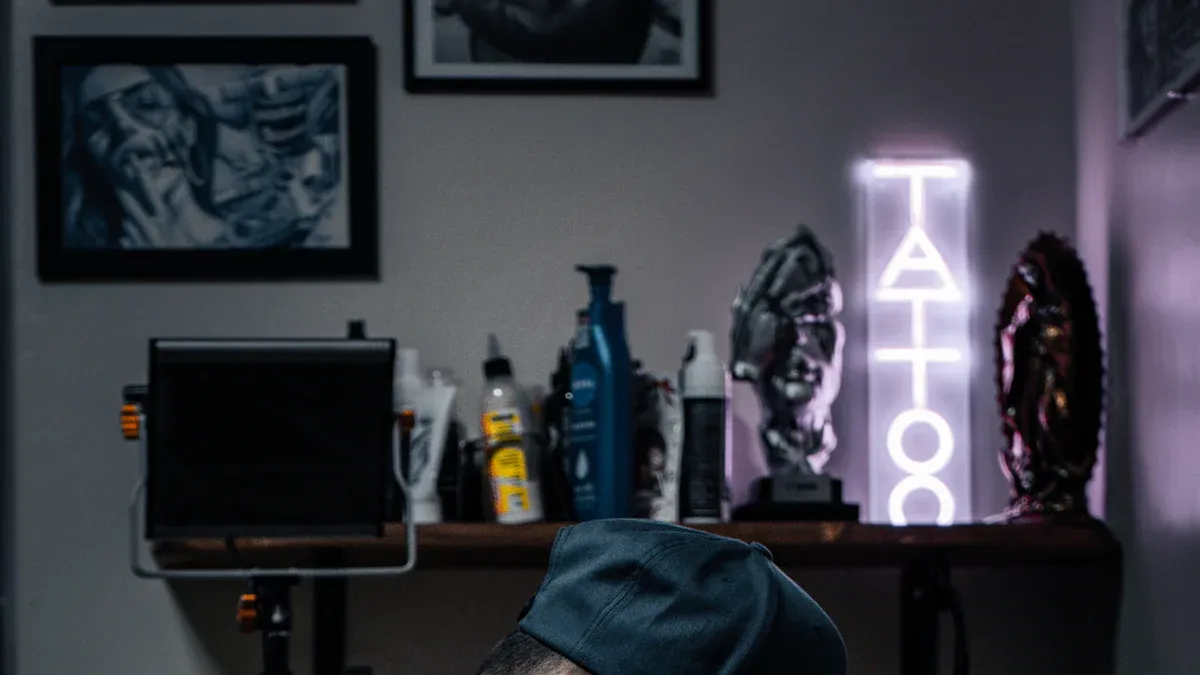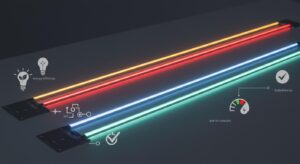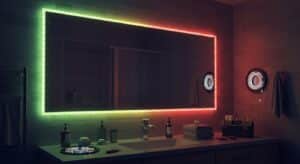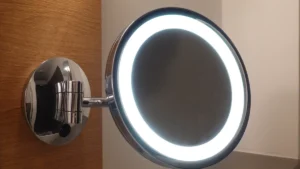
LED neon signs are a modern twist on traditional neon lights, offering vibrant colors and energy efficiency. They’ve become a favorite for DIY enthusiasts like you who want to make your own neon sign. Why? Because they’re safe, easy to work with, and perfect for personalizing spaces.
A DIY neon sign kit gives you the freedom to design your own neon lights exactly how you want them. Whether you’re looking to save money or unleash your creativity, these kits are the way to go. Plus, creating neon lights at home is incredibly rewarding—it’s not just about the final product but the joy of building it yourself.
The popularity of DIY LED neon sign kits has skyrocketed. In 2022, the LED neon lights market was valued at $1.26 billion, and it’s expected to grow by over 6.5% annually through 2032. This means more people are discovering how fun and satisfying it is to design and build their own neon signs.
So, grab a neon sign kit, and let’s make your own neon sign a reality. It’s time to turn your ideas into glowing works of art!
Key Takeaways
LED neon signs are safe, use less energy, and can be customized. They are great for DIY projects.
A DIY neon sign kit has LED strips, a power supply, and an acrylic board. These give you everything to make your design.
Plan your design carefully. Draw your ideas, pick colors and fonts, and keep it simple for the best look.
Be safe with electrical parts. Unplug before touching wires and check connections are tight.
Make your neon sign unique. Use special colors, fonts, and decorations to show your style and make it pop.
Understanding LED Neon Signs
What makes LED neon signs unique?
LED neon signs are special because they mix new technology with the classic look of old neon lights. Instead of using breakable glass tubes with gas, they use bendable LED strips inside strong tubing. This makes them safer, saves energy, and lets you design them easily.
For instance, old neon signs need high voltages (3,000-15,000 volts) to work. LED neon signs only need 12-24 volts. This lowers energy use and makes them safer to touch. Also, LED signs last much longer—up to 50,000 hours compared to the 10,000 hours of old neon signs.
Another cool thing is their flexibility. LED neon signs come in many colors and styles. You can make a bold design for your living room or a soft glow for your bedroom. They can fit any space you want to decorate.
How LED neon signs work
LED neon signs use LED strips to light up. These strips have tiny lights called LEDs that shine brightly and evenly. The LEDs are inside soft tubing that you can shape into different designs.
Here’s how they work:
Power Supply: The LED strips connect to a low-voltage power source. This keeps them safe and energy-efficient.
Light Emission: When electricity flows through the LEDs, they light up in bright colors.
Diffusion: The tubing spreads the light, giving it a smooth, neon-like glow.
This simple design makes LED neon signs easy to build and take care of. You don’t have to worry about glass breaking or harmful gases, so they’re great for DIY projects.
Components of a DIY neon sign kit
A DIY neon sign kit has all the parts you need to make your glowing design. Here’s what’s included:
LED Strips: These are the main part of your sign, providing the light. Good-quality strips can last up to 50,000 hours, keeping your sign bright for years.
Power Supply: A low-voltage adapter powers the LED strips safely and efficiently.
Acrylic Backboard: This is the base where you attach your design. It’s sturdy and holds everything in place.
Wiring and Connectors: These link the LED strips to the power supply.
Adhesives or Clips: These hold the LED strips on the backboard, keeping your design secure.
Some kits may also include extras like dimmers or remotes for more control. With these tools, you can easily create your own neon sign masterpiece.
Materials and Tools for DIY Neon Signs

Creating your own neon sign DIY project starts with gathering the right materials and tools. Let’s break it down so you know exactly what you’ll need.
Essential materials
To build diy neon signs, you’ll need a few key materials. These are the building blocks of your project, so choosing high-quality options is important. Here’s what you’ll need:
LED Strips: These are the heart of your neon sign. Look for strips that are bright, durable, and energy-efficient. For example, LUMINEX™ LED strips offer 20% more brightness than SPLICE™, making them perfect for indoor projects. If you’re planning to use your sign outdoors, SPLICE™ strips are a better choice because they’re weather-resistant with an IP67 rating.
Power Supply: A reliable power source keeps your neon sign glowing. Most DIY kits include a low-voltage adapter, which is safe and efficient. Both LUMINEX™ and SPLICE™ strips can last up to 100,000 hours, so you won’t have to worry about replacing them anytime soon.
Acrylic Backboard: This is the base where you’ll attach your design. Acrylic is lightweight, sturdy, and easy to work with. It holds your LED strips securely and gives your sign a polished look.
These materials form the foundation of your neon sign. Investing in good-quality components ensures your project will look great and last for years.
Tools for assembly
Once you’ve got your materials, you’ll need the right tools to put everything together. Don’t worry—you probably already have some of these at home.
Cutting Tools: A sharp pair of scissors or a craft knife works well for cutting LED strips and tubing.
Adhesives: Use strong adhesives or clips to attach the LED strips to the backboard. Silicone glue is a popular choice because it’s flexible and holds up over time.
Wiring Tools: A basic wire stripper and a small screwdriver are essential for connecting the LED strips to the power supply.
Having these tools on hand makes the assembly process smooth and stress-free. You’ll be surprised at how quickly your neon sign starts to take shape.
Tip: Keep your workspace organized while assembling your neon sign. A clutter-free area helps you avoid mistakes and makes the process more enjoyable.
Optional materials for added customization
Want to take your diy neon signs to the next level? Adding a few optional materials can make your project even more unique.
Dimmers or Remote Controls: These let you adjust the brightness and color of your neon sign. They’re great for creating different moods or settings.
Colored Tubing: While most LED strips come in standard colors, you can use colored tubing to add an extra pop of vibrancy.
Decorative Elements: Think about adding stickers, paint, or other embellishments to your acrylic backboard. These small touches can make your neon sign truly one-of-a-kind.
Customizing your neon sign is where the fun really begins. Let your creativity shine and make something that reflects your personality.
Step-by-Step Guide to Building a Neon Sign DIY Project
Designing your sign (sketching and planning)
Before you start building your neon sign, take some time to plan your design. This step is all about turning your ideas into a clear and workable sketch.
Choose Your Design: Think about what you want your neon sign to say or show. It could be a word, a phrase, or even a simple shape. Keep it bold and easy to read.
Pick a Font and Color: If you’re creating text, choose a font that matches the vibe you’re going for. For example, cursive fonts look elegant, while blocky fonts feel modern. Then, decide on the color of your LED strips.
Sketch It Out: Use a pencil and paper to draw your design. Make sure it fits the size of your acrylic backboard. If you’re not confident in your drawing skills, you can print a template to trace later.
Plan the Layout: Think about how the LED strips will bend and connect. Avoid sharp corners since the strips are flexible but not rigid.
Tip: Keep your design simple if this is your first project. Complex shapes can be tricky to work with, especially when bending the LED strips.
Preparing materials (cutting, shaping, and assembling)
Once your design is ready, it’s time to prepare the materials. This step involves cutting, shaping, and assembling the components of your neon sign.
Cut the LED Strips: Measure the LED strips against your design. Use scissors or a craft knife to cut them to the right lengths. Most LED strips have marked cutting points, so follow those for clean cuts.
Shape the Tubing: If your LED strips come with flexible tubing, carefully bend it to match your design. Take your time to avoid kinks or uneven curves.
Attach to the Backboard: Place your design template on the acrylic backboard. Use adhesive or clips to secure the LED strips in place. Silicone glue works well because it’s strong and flexible.
Double-Check Your Work: Before moving on, make sure everything lines up with your original sketch. Adjust as needed to ensure your neon sign looks just right.
Note: If you’re using colored tubing or decorative elements, now’s the time to add them. These extras can make your custom neon signs stand out even more.
Wiring and connecting LED strips
Now comes the technical part—wiring and connecting the LED strips. Don’t worry; it’s easier than it sounds if you follow these steps.
Understand the Power Requirements: Most LED strips need a 12V or 24V power supply. Check the specifications of your strips to ensure compatibility.
Choose a Wiring Method:
Parallel Wiring: This is the best option for connecting multiple strips. It minimizes voltage drop and keeps the brightness consistent.
Series Wiring: You can use this for simpler designs, but keep the total length under 5 meters to avoid dimming.
Connect the Strips: Use plug-and-play connectors for an easy setup, or solder the wires directly for a more secure connection. Make sure the polarity (+ and -) matches on all connections.
Test for Voltage Drop: After connecting, test the voltage at the end of the strips. It shouldn’t drop more than 1.5V. If it does, adjust the wiring to maintain uniform brightness.
Power It Up: Plug the power supply into an outlet and turn on your neon sign. Check that all sections light up evenly.
Important: Ensure the total current draw of your LED strips doesn’t exceed the power supply’s rated output. This prevents overheating and ensures your neon sign lasts longer.
By following these steps, you’ll have a fully wired and glowing neon sign ready to display.
Mounting and testing your DIY neon sign
Now that your neon sign is wired and ready, it’s time to mount it and see it in action. This step is all about securely attaching your sign to its display surface and testing it to ensure everything works perfectly. Let’s dive in!
Mounting your neon sign
Mounting your neon sign is easier than you might think. Follow these steps to get it up on your wall or display area:
Choose the Right Spot: Pick a location where your sign will stand out. Make sure there’s a nearby power outlet for easy access.
Prepare the Surface: Clean the wall or surface where you’ll mount the sign. Dust or grease can weaken adhesives or mounting hardware.
Attach the Backboard:
If your acrylic backboard has pre-drilled holes, use screws and wall anchors to secure it.
For a no-drill option, use heavy-duty adhesive strips or hooks. These work well for lightweight signs.
Hide the Wires: Use cable clips or a cord cover to keep the wires neat and out of sight. This gives your setup a professional look.
Tip: If you’re mounting your sign outdoors, make sure the materials and adhesives are weather-resistant.
Testing your neon sign
Once your sign is mounted, it’s time for the moment of truth—testing it! Here’s how to do it step by step:
Double-Check Connections: Before plugging it in, inspect all the wiring. Ensure the LED strips are securely connected to the power supply.
Power It On: Plug the power adapter into the outlet and switch it on. Your neon sign should light up immediately.
Inspect for Issues: Look for any dim sections or flickering lights. These could indicate loose connections or a voltage drop.
Adjust Brightness: If your sign includes a dimmer or remote control, test these features to find the perfect brightness level.
Note: If your sign doesn’t light up, don’t panic. Unplug it and recheck the wiring. Make sure the polarity matches and all connections are secure.
Final touches
Take a step back and admire your work. Does the sign look straight? Are the wires hidden? Make any final adjustments to ensure your neon sign looks its best. Once you’re satisfied, you’re all set to enjoy your glowing masterpiece!
Pro Tip: Turn off your neon sign when it’s not in use to extend the lifespan of the LED strips.
Tips for Designing DIY Neon Signs
Picking colors and fonts that stand out
The colors and fonts you pick can change your neon sign’s look. Colors are super important because they affect how people feel about your sign. Did you know most first impressions come from color? That’s why choosing the right shades matters. Here’s how colors can influence your design:
Fact | Meaning |
|---|---|
90% | First impressions depend on color |
60% | People avoid items with disliked colors |
80% | Color helps people remember brands |
43% | Black is linked to quality |
29% | Purple is tied to bravery |
26% | Yellow feels fun and happy |
For fonts, keep it simple. Fancy cursive fonts look nice but are hard to read far away. Clear fonts like Arial or Helvetica are easier to see and give a modern vibe. Using bold colors with simple fonts makes your neon sign noticeable and easy to read.
Making it pretty but readable
A neon sign should look good and be easy to read. Follow these tips to balance style and readability:
Use strong contrast. Bright lights on dark backgrounds work well.
Keep it simple. Don’t add too many extra details.
Follow accessibility rules. Use a contrast ratio of 4.5:1 or higher.
Pick the right size. Make sure the text is big enough to see clearly.
By focusing on these points, your neon sign will look great and be easy to understand.
Arranging your sign for different places
Where you put your neon sign changes how it looks and works. A good layout helps your sign stand out. Here are tips for different spots:
Inside spaces: Place your sign on a plain wall for better visibility. Use lights to highlight special areas like sales or new items.
Outside spaces: Hang your sign high so people driving by can see it. Make sure it’s in a safe, dry spot.
Shops or events: Put your sign near entrances or key areas. This grabs attention and creates cool photo spots.
Placing your sign well makes it easier to see and enjoy for everyone.
Safety Tips for DIY Neon Signs
Making your own neon sign is fun, but safety is key. Follow these tips to keep your project safe and long-lasting.
Staying safe with electrical parts
Working with electrical parts can seem tricky, but it’s simple if you’re careful:
Unplug first: Always unplug the power before touching wires or LED strips. This stops accidental shocks.
Match the voltage: Check that your power supply matches your LED strip’s voltage. Most kits use 12V or 24V, which are safe.
Secure wires: Use connectors or solder wires tightly. Loose wires can cause flickering or overheating.
Check for damage: Look for broken wires or parts before plugging in. Replace anything unsafe.
Tip: Keep a fire extinguisher nearby when working with electrical parts, just in case.
Using tools and glue the right way
The tools and glue you use are important for your project’s success. Here’s how to use them safely:
Cut carefully: Use sharp scissors or knives to cut LED strips. Dull tools can ruin the edges or damage materials.
Use glue sparingly: A small amount of silicone glue works best. Too much can weaken the hold.
Read instructions: Follow the directions on tools and glue. Some glues need time to dry, while others work fast.
Wear safety gear: Use gloves for glue and goggles for cutting. These protect you from accidents.
Note: Work in a space with fresh air when using glue to avoid breathing in fumes.
Making your sign strong and long-lasting
Want your neon sign to last a long time? Follow these tips to keep it sturdy:
Test it first: Let your sign run for 8 hours after building it. This helps spot problems early.
Pick good materials: Silicone-covered LED strips handle heat better and last longer.
Mount securely: Use strong screws or adhesive strips to hold your sign in place. A shaky sign can break easily.
Here’s a quick look at how durability helps your neon sign last:
Evidence Description | Details |
|---|---|
Lighting and Aging Tests | Signs are tested for 8 hours to ensure they work well. |
Lifespan of Signs | Neon signs can last 30,000 to 35,000 hours, or up to 15 years. |
Material Durability | Silicone-covered LED strips resist heat, making them last longer. |
Pro Tip: Turn off your neon sign when not in use. This simple step helps it last longer.
By following these safety steps, you’ll create a neon sign that’s both beautiful and safe for years to come.
Creative Ideas for DIY Neon Signs

Unique designs for home decor
Neon signs can change how your home feels. They add a cozy glow to bedrooms or a bold look to living rooms. You can make a sign that shows your personality, like a favorite quote, fun shape, or your name.
Mix old-fashioned charm with modern style for inspiration. Warm white or amber lights create a welcoming feel. Bright blue adds energy. Curvy shapes and straight lines together make your sign look trendy and timeless.
Feature | Description |
|---|---|
Design Style | Combines vintage charm with modern looks for home decoration. |
Colors | Warm whites, amber, and blue make signs stand out and look great. |
Font Choice | Bold and simple fonts create a friendly and inviting feel. |
Shape Ideas | Curves and clean lines balance the design for day and night appeal. |
Glow Effect | Letters shine softly, making the sign visually impressive. |
Mood | Creates a cozy and fresh vibe, perfect for home spaces. |
Neon signs are popular again because they’re bright and easy to customize. LED neon flex lights help you make cool designs while saving energy.
Neon signs for events and businesses
Neon signs are great for parties, weddings, and businesses. They grab attention and leave a lasting memory. For weddings, try phrases like “Forever Together” or “Love Always.” At parties, fun shapes like drinks or balloons make the space lively.
Businesses use neon signs to stand out. They’re like a cool outfit for your brand. For example, Nike used neon signs to show off their slogan, boosting sales. IKEA UK added neon signs in stores, attracting millions of visitors.
Brand | Description | Impact |
|---|---|---|
Nike | Neon signs made their slogan more visible. | Sales grew from $877 million to $9 billion, with 10% growth in 2023. |
IKEA UK | Custom neon signs improved the store experience. | Brought in 47 million visitors in 2022-2023. |
24/7 Fitness | Neon signs matched their brand colors and inspired customers. | Helped grow membership to over 50,000 and boosted social media. |
LED neon flex lights are perfect for events or businesses. They’re bright, durable, and eye-catching.
Popular trends in DIY neon signs
DIY neon signs are super popular right now. People love them because they look cool and can be customized. Businesses use them to stand out, and homeowners enjoy adding personality to rooms.
New ideas like flexible neon lights and energy-saving designs make them even better. These features make it easy to create amazing signs. Whether for a cozy home or busy business, LED neon flex lights are the top choice.
Why neon signs are trending:
They look amazing and help brands get noticed.
Energy-saving designs are good for the planet.
Flexible styles let you get creative with your designs.
DIY neon signs are fun and rewarding. They’re more than lights—they’re a way to show your style.
Creating your own LED neon sign is easier than you might think. You’ve learned how to design, assemble, and wire your sign step by step. Along the way, you’ve discovered the benefits—customization, cost savings, and the joy of building something unique.
Remember: With the right tools and a little creativity, you can bring any idea to life.
So, why wait? Grab a DIY neon sign kit and start your project today. Whether it’s for your home, an event, or a business, your glowing masterpiece is just a few steps away. You’ve got this!
FAQ
What’s the difference between LED neon signs and traditional neon signs?
LED neon signs use flexible LED strips instead of glass tubes filled with gas. They’re safer, more energy-efficient, and easier to customize. Traditional neon signs are fragile and require high voltage, while LED signs are durable and beginner-friendly for DIY projects.
How long do LED neon signs last?
High-quality LED neon signs can last up to 50,000 hours. That’s about 5-6 years of continuous use! To extend their lifespan, turn them off when not in use and avoid exposing them to extreme heat or moisture.
Can I use my DIY neon sign outdoors?
Yes, but only if you use weather-resistant materials. Look for LED strips with an IP67 rating and use waterproof adhesives. Make sure all wiring is sealed to prevent water damage. For extra protection, mount your sign in a covered area.
Do I need special tools to make a neon sign?
Not really! Most DIY kits include everything you need. You’ll just need basic tools like scissors, a screwdriver, and glue. If you want to solder wires, a soldering iron can help, but it’s optional for most projects.
Can I fix my neon sign if it stops working?
Yes, most issues are easy to fix. Check the wiring connections first. If a section doesn’t light up, it might be a loose wire or a damaged LED strip. Replace faulty parts and test again. Always unplug the sign before troubleshooting.
Tip: Keep extra LED strips and connectors handy for quick repairs.
See Also
Steps to Create Stunning LED Neon Sign Designs
Guide to Making Your Personalized Neon LED Sign
Instructions for Creating an LED Neon Flex Sign
Overview of LED Neon Flex Types and Their Setup
Illuminate Your Area with Custom Neon LED Signs



